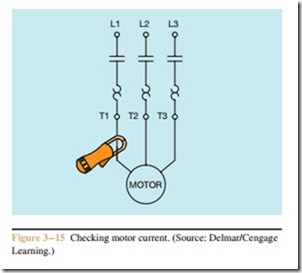Troubleshooting
Anytime a motor has tripped on overload, the electrician should check the motor and circuit to determine why the overload tripped. The first step is generally to determine if the motor is actually overloaded. Some common causes of motor overloads are bad bearings in either the motor or the load the motor operates. Shorted windings in the motor can cause the motor to draw ex- cessive current without being severe enough to blow a fuse or trip a circuit breaker. The simplest way to deter- mine if the motor is overloaded is to find the motor full load current on the nameplate and then check the running current with an ammeter (Figure 3–15). If checking a single-phase motor, it is necessary to check only one of the incoming lines. If checking a three- phase motor, check each line individually. The current flow in each line of a three-phase motor should be close to the same. A small amount of variation is not uncommon, but if the current is significantly different in any of the lines, that is an indication of internally shorted windings. Overloads are generally set to trip at 115% to 125% of motor full load current, depending on the motor. If the ammeter reveals that the motor is drawing excessive current, the electrician must determine the reason before the motor can be put back into operation.
Excessive current is not the only cause for an over- load trip. Thermal overloads react to heat, so any heat source can cause an overload to trip. If the motor is not drawing an excessive amount of current, the electrician should determine any other sources of heat. Loose connections are one of the greatest sources of heat. Check
the wires for insulation that has been overheated close to terminal screws. Any loose connection on the starter can cause an overload trip; make sure that all connections are tight. Another source of heat is ambient, or surrounding, air temperature. In hot climates, the surrounding air temperature combined with the heat caused by motor current can be enough to cause the overload to trip. It may be necessary to set a fan that blows on the starter to help remove excess heat. Manual starters that are installed in a switchbox inside a wall are especially susceptible to ambient temperature problems. In this case, it may be necessary to install some type of vented cover plate.
Review Questions
1. A single-phase 120 volt motor is controlled by a manual motor starter. The motor is not running, and the switch handle on the starter is found to be in the center position. What does this indicate?
2. Referring to the above question, what action is necessary to restart the motor and how is it accomplished?
3. A single-phase motor operates on 240 volts. Why should a starter that contains two load contacts be used to control this motor?
4. A push-button manual starter has tripped on over- load. Explain how to reset the starter so the motor can be restarted.
5. What is meant by the term “line voltage” on some pilot sensing devices?
6. Explain the difference between manual motor starters that provide low voltage release and those that do not.
7. What is the simplest way to determine if a motor is overloaded?
8. Refer to the circuit shown in Figure 3–7. What type of switch is connected in series with the motor, and is the switch normally open, normally closed, normally open held closed, or normally closed held open?
9. Refer to the circuit shown in Figure 3–10. When would the amber pilot light be turned on?
a. When the manual-automatic switch is set in the MAN. position.
b. When the float switch contacts are closed.
c. Anytime the manual starter is turned on.
d. Only when the manual-automatic switch is set in the MAN. position.
10. Refer to the circuit shown in Figure 3–10. Is the float switch normally open, normally closed, normally open held closed, or normally closed held open?
